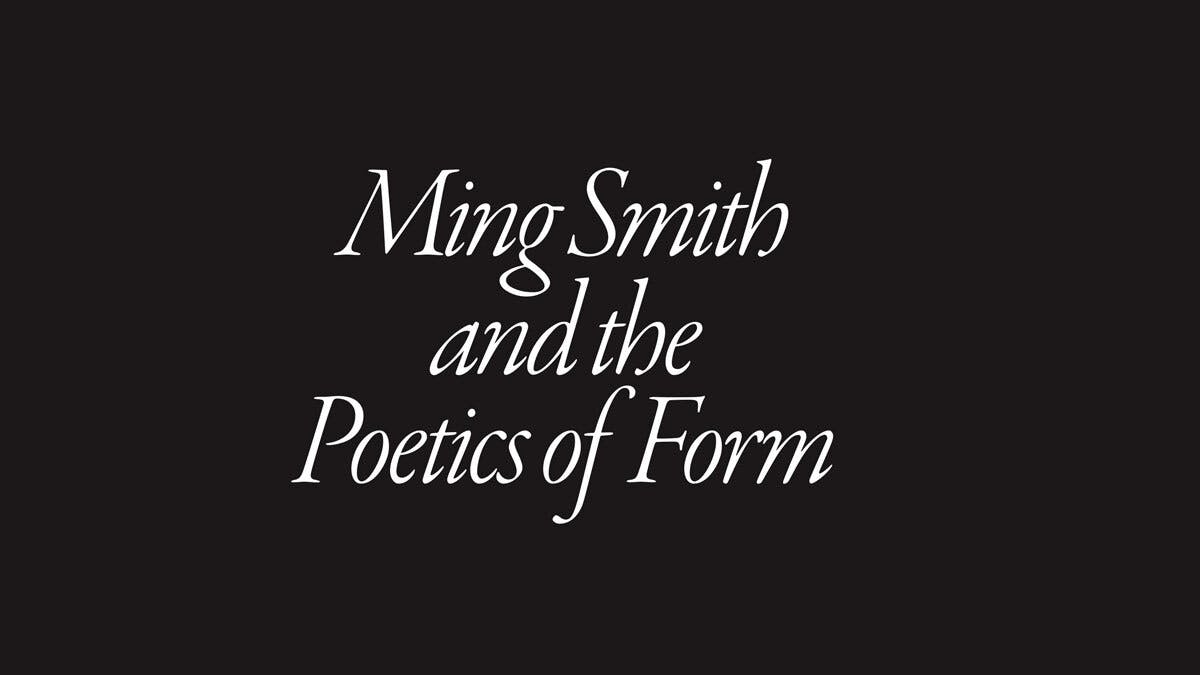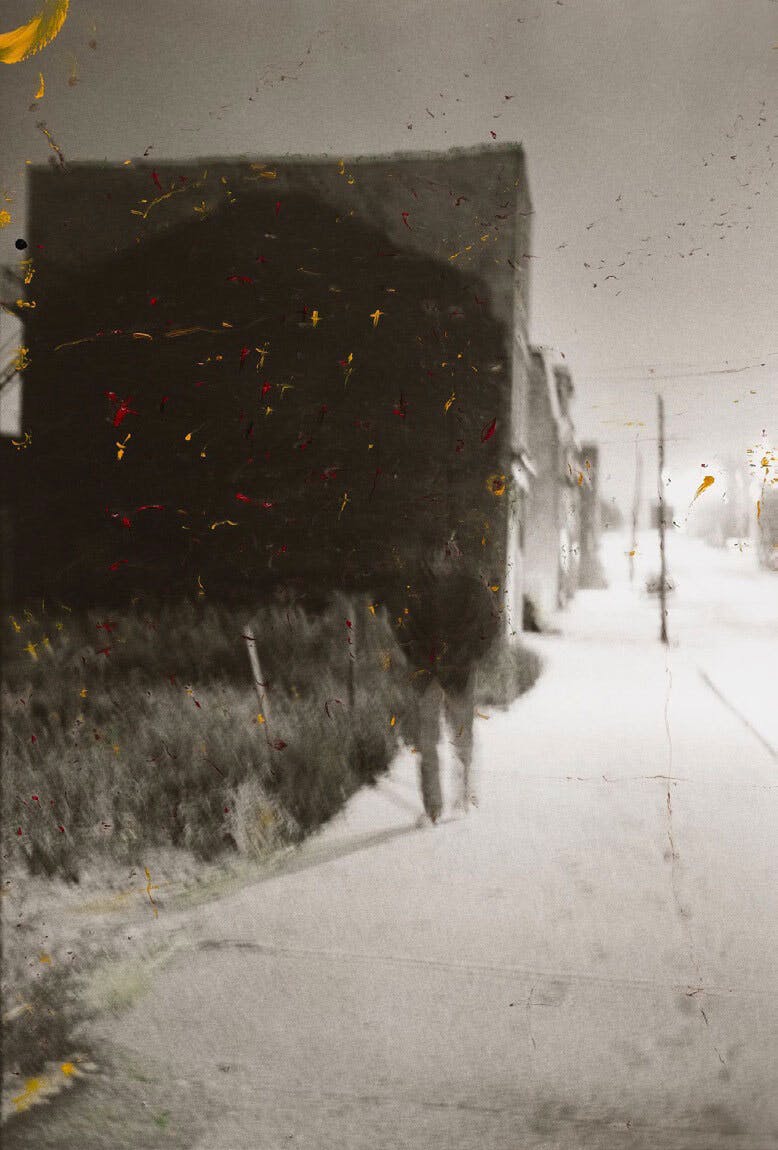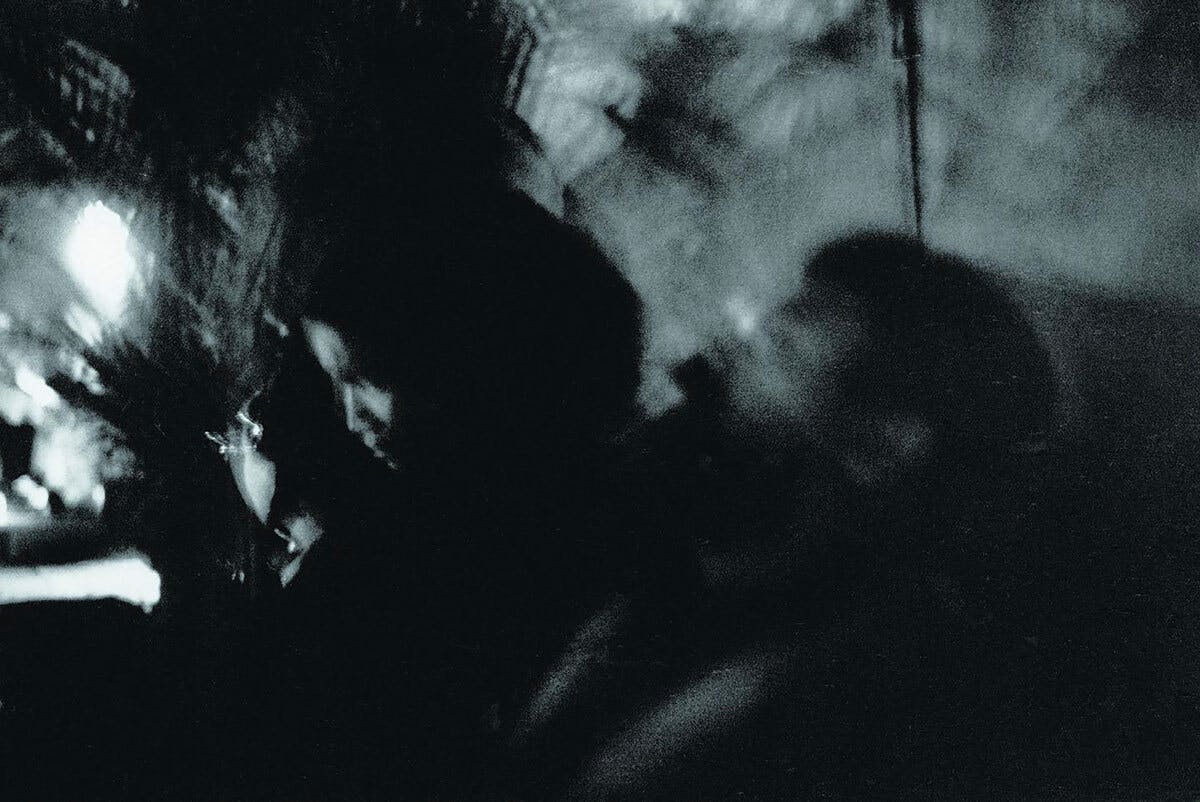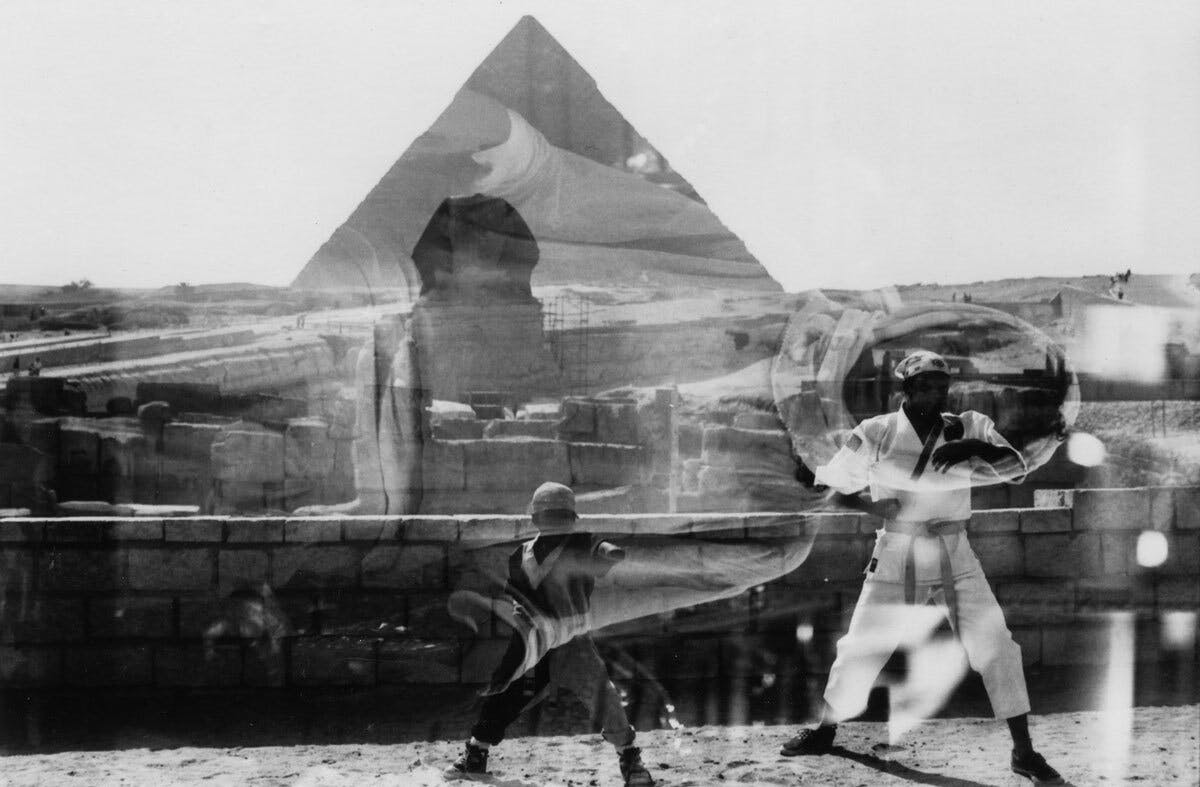Ming Smith and the Poetics of Form


Sole figure on a sidewalk: his soles just out of focus, creating the illusion that he is floating. Invisible man, somewhere, everywhere—a ghost in what appears to be a ghost town. He nestles his hands in the pockets of a dark coat. He leans at the waist as if bracing a breeze. The man walks past an overgrown plot, wild and windblown, navigating a sidewalk empty except for him and the slight stamp of footprints on the pavement— their authors long gone. The footprints are phantasmal, a memory amid the monochromatic print. Moody. Snow dusts the pavement. Two trails begin as quickly as they end, paralleling the man’s path. His body is barely perceptible, swallowed by the looming building behind him. If it weren’t for his legs contrasting with the sidewalk’s pavement, the man’s amorphous form would be rendered imperceptible.
Light confirms my reality, gives birth to my form … Without light, I am not only invisible, but formless as well; and to be unaware of one’s form is to live a death.
— Ralph Ellison, Invisible Man
I’ve always followed the light, and I still do.
— Ming Smith


This monochrome print Invisible Man, Somewhere, Everywhere (1991), which takes its inspiration from Ralph Ellison’s eponymous 1952 novel, is a highlight from Projects: Ming Smith, organized by Thelma Golden, Director and Chief Curator of The Studio Museum in Harlem, and Oluremi C. Onabanjo, Associate Curator in the Department of Photography at the Museum of Modern Art, with the assistance of Kaitlin Booher, Beaumont and Nancy Newhall Curatorial Fellow, Department of Photography, The Museum of Modern Art, and Habiba Hopson, Curatorial Assistant, Permanent Collection, The Studio Museum in Harlem. Projects features a version of the gelatin silver print embellished with the artist’s yellow and red-hued paint flecks. Like Smith, Ellison was fascinated with light, describing its capacity to confirm reality, which he understood as a revelation of truth. In the introduction of Invisible Man, the author details the capacity of light to bring into being that which was obscured by darkness, reminiscent of the birth of creation divinely orchestrated in the Book of Genesis. Speaking in an interview conducted by Zoe Whitley, Director of Chisenhale Gallery, London, Smith notes that she’s also dealing with the light in the shadows.1This act reflects the idea of poiesis, the Greek root of poetry, which ultimately describes bringing into being that which did not exist before. Ellison suggests that light is poetic in form, that poetry, like light, can make the invisible visible.
Following Ellison’s literary frame of reference, the resonances in Smith’s images—"the hue of sound, the rhythm of form, the texture of vision”—come to life.2 Poet Amiri Baraka once said, “We need art to express what cannot be explained.”3 Smith, painter of light, has carved out a photographic practice steeped in aura and atmosphere, depicting the sensual and sensorial, bringing into being that which cannot be put into words. Through long exposures, hazy overlays, and shadowy doubles, her photography articulates a visual poetic illuminating an intimate and studied fascination with the figurative language of Black life. Projects: Ming Smith offers an archival reintroduction to the photographer’s work, ensembled to draw connections between her poetic and political praxes. Highlighting the myriad ways Smith’s oeuvre intimates or evokes complex sensorial experiences, the exhibition offers ample space to reflect on the poetics of the photographic image, meditating through Smith’s plays on the limitlessness of form.
In Amina and Amiri Baraka (Lovers) (1980), Smith depicts the titular couple in a dark room revealed by a distant light. The photographer’s use of long exposure imparts a smooth, sultry texture to the image—it shimmers like a puddle of gasoline. Light’s play against the bodies obscures their fluid postures, muddying the embrace. Amina’s head tilted forward, Amiri’s tilted back, a slew of questions commence: Are his eyes closed or glimpsing up at her? Is she listening or attempting to tune him out? Are they sitting in quiet or bathed in sound? Darkness permeates the scene, concealing the details of a moment’s passage. Here, Smith seems to repurpose Toni Morrison’s idea of “romancing the shadow” as darkness eclipses an intimate exchange.4 She does not manipulate blackness to give form to light or expose some vestige of the socialites’ interiority. She instead hints at the elusive secrets that result from playing in the dark.
The blur reads as intentionally obtuse, giving way to an opacity heightened by a dizzying usage of long exposure. Time moves slowly and curiosity submits to the night, acquiescent. We have no right to the inside joke, the private whisper, the deep-rooted sigh, the tense silence. This is our only provision before we are met with the next set of questions: How do we decipher love? How does love decipher us?


Smith’s work invites us to trust ourselves and follow our intuition. The blur necessitates discernment and a willingness to see what is not and what could be—remembering the body’s composition, despite a figure being draped in shadow, or recalling that legs require a body to move amid the haze of light in snowfall. Smith plays with perception, allowing her images to drift into dreamlike reverie, a momentary escape from a social reality that seeks to limit Black possibility. As Audre Lorde reveals: it is our dreams that point the way to freedom.5 In her essay, “Poetry Is Not a Luxury,” Lorde expands the poetics of light evoked by Smith and Ellison:
The quality of light by which we scrutinize our lives has direct bearing upon the product which we live, and upon the changes which we hope to bring about through those lives. It is within this light that we form those ideas by which we pursue our magic and make it realized. This is poetry as illumination, for it is through poetry that we give name to those ideas which are—until the poem—nameless and formless, about to be birthed, but already felt.6
Smith’s long-exposed images are invitations to meet photographs with a sensorial embrace and return to the body. In this way, long exposure surfaces as an extended metaphor for poiesis’ slowed, measured labor—the gradual gestation of words yet to be articulated. Womb (1992) is a double-exposed image that traverses categorical notions of time and space, illustrating their malleability. The image captures the passage of time, while also providing room for considerations of memory, simultaneity, and superposition. As if viewed through a window, two children (the artist’s sons) pose with powerful martial art stances in front of the great pyramids of Giza superimposed onto the Sphinx, also in Giza. Turning the image’s orientation to the left, an additional self-portrait of the artist capturing the scene mirrors the mythical creature’s poised posture. In her essay “We Are the Work,” Miriam Romais describes the symbolic implications of this visual gesture
Smith becomes an energy carried horizontally across the entire frame—past the pyramid, the sphinx, and over to her sons where she sits, evoking queens and deities presiding over their fortress and fortune. Her wrapped face becomes the window, in which the past and present merge.7
Referencing ancient and contemporary notions of derivation and origination, Smith fuses imagery that captures a photograph’s conception, while also resembling the shadowy monochromatic frame of a child-bearer’s ultrasound. Reorienting the photograph, we shift from viewer to viewed as we meet Smith’s gaze. She is the work—the medium is the message. This bringing into being witnessed across Ming Smith’s oeuvre, brought to light through a virtuosic incorporation of long exposure and blurring, comes to represent the formation of visual and figurative language that addresses topics of opacity, invisibility, and self-perception. Ushering in a poetics of form, Smith excavates the shadows. She is an illuminator—wielding her camera and brush to paint what so many have yet to see.


Notes
1) "Interview with Ming Smith,” interview by Zoe Whitley, White Review, no. 30 (March 2021), thewhitereview.org/feature/interview-with-ming-smith/.
2) The Museum of Modern Art, “Projects: Ming Smith,” MoMA, accessed March 8, 2023, moma.org/calendar/exhibitions/5514.
3) The Graduate Center, CUNY, “CHANGE: A World Without Prisons: Ruth Wilson Gilmore in Conversation with Mariame Kaba,” YouTube, September 23, 2020, livestream event recording, youtube.com/watch?v=oeQmVpnRMYE&t=528s.
4) Toni Morrison, Playing in the Dark: Whiteness and the Literary Imagination (Cambridge, MA: Harvard University Press, 1992), 29.
5) Audre Lorde, “Poetry Is Not a Luxury,” Sister Outsider: Essays and Speeches (New York: Penguin Books, 2020), 24.
6) Ibid.
7) Miriam Romais, “We Are the Work,” Women’s Work: Art and Activism in the 21st Century, ed. Grace Aneiza Ali and Celeste Hamilton Dennis (New York: Pen and Brush, 2019), 38–39, ofnotemagazine.org/current-issue/.